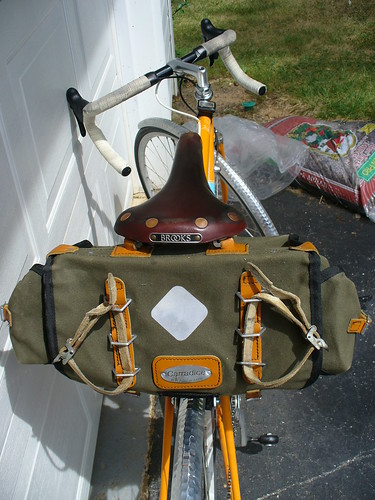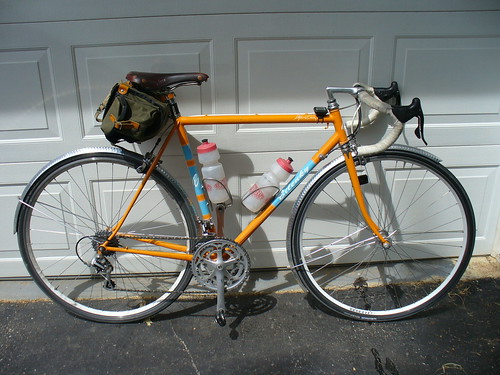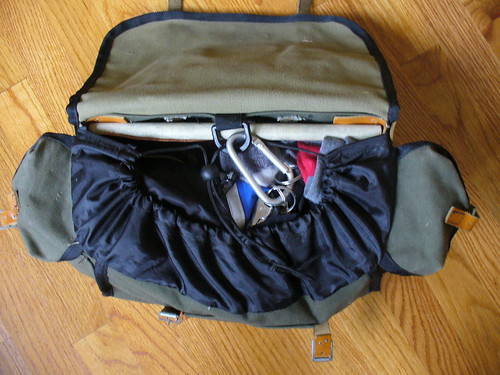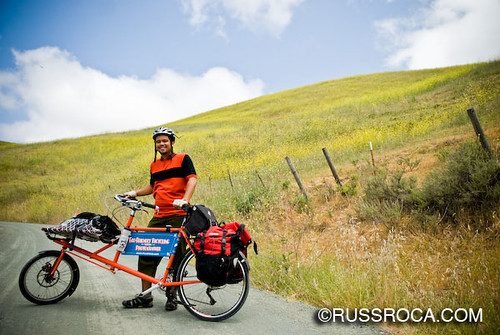
After a disastrous experience using an over-stuffed zip-up nylon saddlebag on a 200km brevet, I had to find something that would both be both eye-pleasing and big enough to not spill open and randomly drop important items. The carradice barely has filled that role perfectly, with more than enough room for any 200 or 300k ride, the ability to be overstuffed as well as to have a wet rain jacket strapped and dried on the outside via toestraps (not supplied with the bag). The size is such that short rides I can suffice with only my jersey pockets, but on anything where a rain jacket or extra food, clothes, and tools may be needed the bag is used. I tend to use it mainly for rides closer to century distances and beyond, riding in unpredictable weather, or if I simply want to ride to a distant park or coffee shop with a book. Because of this, it has also replaced an awkward and ugly handlebar bag that I had used previously. For cue sheets, a zip lock bag held with binder clips zip-tied to the handlebars works splendidly, and nutritious treats strategically placed in jersey pockets provide nourishment.
The bag is fitted to the bike by three leather straps. Two are threaded through the bag loops on the saddle (Velo-orange sells attachable bag loops for saddles lacking them) that also wrap around a wooden dowel to add internal support. The third wraps around the seatpost to prevent the bag from rocking back and forth. The leather straps fit snugly, and the size of the bag is just small enough to not need any extra support by means of a rack. A wine cork placed between seatpost and bag is enough to keep my thighs from touching the bag, but it's often not needed if the bag is not full. If you ride with a zero setback seatpost, you most likely won't need the cork. Attaching the bag to the bike takes two or three minutes, but it's a very secure attachment.
The opening of the bag is held closed in typical carradice fashion with leather straps, but a nylon drawstring closure adds and extra layer of security to prevent any small items from poking out while protecting them from the rain. The bag is not completely waterproof, but it hasn't shown any signs of leaking on the brief heavy showers I've ridden through with it. I think this is a combination of the cotton duck and position of the bag behind the rider, who tends to shield it from the worst of the rain. Still, I recommend using plastic bags for anything that cannot afford to get wet, such as cell phones or spare socks. Additionally, sewn onto the outside of the bag is a spot for a clip on taillight for night riding, as well as a large reflective square for added visibility.
Shown below are some photographs. In the bag I can carry enough foul weather clothing for typical Fall and Winter riding; a rain jacket, long sleeve wool jersey, space socks, knee-warmers, as well as my journal and tools for any mechanical problems. Please note that there is still room for a sandwich and maybe an apple.



(Anecdotal Aside: When I was emailing with Mike about the article he mentioned he had a Bilenky. When I asked which one, he sent me this link. I laughed out loud when I saw it, because I had been drooling over that exact bike many moons ago when I was contemplating ordering my cargo bike. What are the chances?!)

1 comment:
I thought it was maybe a Holdsworth. That orange is very close to the 'racing orange' the Holdsworth team used in the '70's
http://www.classicrendezvous.com/British_isles/Holdsworth.htm
Lovely looking frame.
Post a Comment